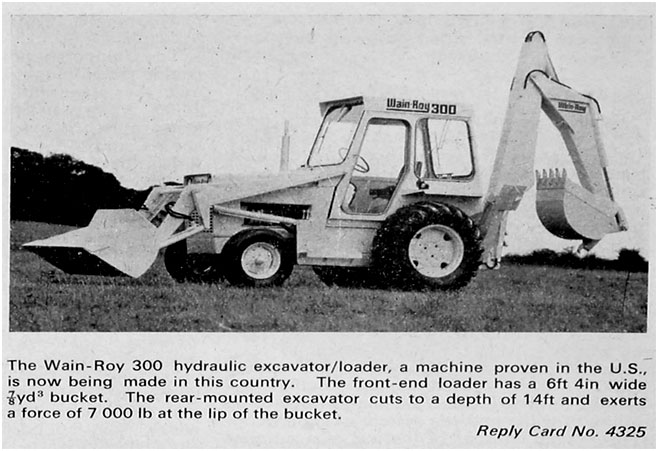Evolution of Backhoe Loaders
Power of the backhoe is hydraulic pressure The backhoe is one of the most commonly seen pieces of construction equipment because of its adaptability. Its cousin, the front-end loader, is also a smaller piece of equipment that has a broad

Power of the backhoe is hydraulic pressure
The backhoe is one of the most commonly seen pieces of construction equipment because of its adaptability. Its cousin, the front-end loader, is also a smaller piece of equipment that has a broad bucket like the one on the front of the backhoe for hauling soil, debris, and materials, and lifting them up into trucks. These two machines have some much larger relatives, including the road grader (with a large blade that smoothes soil surfaces), roller compactor (equipped with a heavy roller that compacts soil and asphalt during construction), the bulldozer and crawler tractor (big loaders that move earth by digging, ripping, and blading, with traction from rolling tracks, not tires), the excavator (a track-mounted vehicle with a much larger bucket than the backhoe), and the scraper (with a large bowl in the center of the machine that cuts into the earth and carries the material it has cut in that bowl). More distant members of the vast construction equipment family are cranes, dump trucks, pipe layers, draglines, truck-mounted drills, and shovels.
The key to the power of the backhoe is hydraulic pressure. Hydraulic lines, a reservoir of hydraulic fluid, a pump, and a series of pistons allow the machine’s operator to extend its arm and cut through soil with a toothed bucket. The pump exerts pressure on the hydraulic fluid, and operating the levers opens a valve that releases the oil into a piston. The piston expands to lift the arm, swing the bucket, press the bucket into the soil, and lift it out of the excavation. Reversing the valve causes the oil to flow out of the piston and return to the reservoir.
The backhoe’s standard equipment is a narrow bucket on the rear end and a loader on the front. The operator effectively makes either device the working end by simply rotating his chair and operating a different set of controls. Typically, if the bucket is being used, the flat front end of the loader is set down on the ground to stabilize the vehicle.
History of heavy excavating machinery
The history of heavy excavating machinery began in 1835 when the dipper shovel was invented to excavate hard soil and rock and to load trucks. The dipper shovel was steam-powered and mounted on rails like a train. Rail lines were laid into mines and large excavations so the dipper shovel could move around and load materials into railroad cars or horse-drawn trucks. The dipper shovel had a short boom (lifting arm), a dipper stick (a beam that pivoted out from the boom and gave the shovel its name), and an attached bucket for digging. The dipper shovel was modified in many ways to create the familiar construction equipment of today; the boom was changed, different attachments were added, the weight and balance of the equipment were changed, and the type of tires or tracks were chosen to suit the equipment’s primary jobs. Of course, with the invention of gasoline-and diesel-powered vehicles, construction equipment became even more adaptable. Most construction equipment is powered by diesel engines, although electric-power, battery power, and propane tanks are used on specialized equipment.
Before Backhoe
The major job and initial job of construction activity is to build a base of any infra structure. This involves digging. Before the backhoes, the construction activity of digging is done by humans with the help of handmade shovels. This method is neither safe nor is very time consuming. Also, the accuracy of the jo is not good. Further the cost per cubic meter is very high. There are many other small problems related to human behavior are there. There is a crucial need of a machinery which can increase the per cubic efficiency of any construction job.
TLB (Tractor-loader-backhoe)
The first TLB which had the capacity to do multiple operations dated back to 1952. The machine in picture is the Wain-Roy 300, a very primeval and prominent machine which was the first authentic patent of its likes.
Although Wain-Roy Corporation no longer exists, the Wain Roy product line of backhoe attachments and couplers are still available through the Woods Equipment Company of Rockford Illinois. The pictures below were taking in the Hubbardston, Massachusetts town center at the Charles Clark Corner.
The evolution into a modern backhoe
Versatility in the state of Economic Turmoil
The falling budgets and the lack of financial support to small businesses and MSMEs force them to decrease their labor cost since this is the only variable cost, they can change. A multi-function backhoe loader can perform a lot of tasks and can be availed once and for all thus reducing the recurring log of expenditure.
Be it the construction of a small house or fixing a patch of broken road, a backhoe loader is a common sight of everyone who passes a construction site.
Easy usage for the operator
The cabin for the operator working inside the backhoe is spacious enough to accommodate him and few of his belongings easily. It also has good leg space allowing the operator to stretch his legs after working for long hours. This added feature increases the productivity and gives this machine a competitive edge against a single utility equipment. The most important part of this machine is its engine which is super tough. However, the quality also depends from companies to companies and therefore someone who buys the loader from a reputed brand will always find his money worth the machine.
Complete Automation of the operations
There is potential for further automation, as well. “Currently, automation will help on operator comfort, and saving time and money in terms of fuel. What we are inclined to see in the future is not only the feature automation but application or operation automation.
Examples
a) Return to Dig function
The operation that will automatically lower the bucket as the operator approaches the pile. “But there are still components in that application that you can automate — for example, raising the arms close to the truck, dumping the bucket, returning the bucket to a position where the return-to-dig can engage.
b) 2D Grade System
There are technologies available today that can be equipped on a backhoe for a 2D grade system. Such systems can help eliminate the need for a grade checker in the trench. More advanced grade control systems with a higher level of precision and automation may also emerge on these machines. “Implementation of electro hydraulic controls can significantly improve the efficiency, preciseness & reliability of many features offered today.
Durability and Endurance
As the engine’s capacity is always getting better, the consumer welfare is also kept in mind while advancing the R&D. The makers have now ascertained that the thought before procuring the machine is not for a momentary purpose but a long-lasting goal which can be associated with the intention. The machines are built to maximize the productivity and to endure all the on road and off-road burden while still being fully optimized and functional.
Customer’s Direct Access
With the marketing philosophy now being changed to the paradigm where after sales and quality is prominent and not the quantity, companies have started to focus on crafting the tech of the product as per the need of the consumer. Since the decision-making authority lies with the buyer and there are several options available, what intrigues the customer in a hearty manner is the involvement they have with the machinery and how they can also follow the trajectory of operations.
The levels of integration have risen, and the customer has now been put directly in the operator’s seat without being there physically but by tracking every hook and corner virtually. While some customer does follow the conventional approach and don’t want any improvement, the companies are thriving hard to strike the requited balance.
Pilot and Electro hydraulic controls
May it be the wobble stick or the EC and AEC, everything has been focused in order to enhance the productivity per unit of time. The extra efforts to increase the magnitude of EHC has landed the companies in a pool of profits and the contractors in a pool of saving their resources.

Hits: 40








